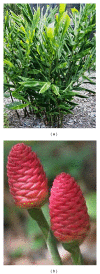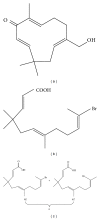Biomedical properties of a natural dietary plant metabolite, zerumbone, in cancer therapy and chemoprevention trials
- PMID: 25025076
- PMCID: PMC4082908
- DOI: 10.1155/2014/920742
Biomedical properties of a natural dietary plant metabolite, zerumbone, in cancer therapy and chemoprevention trials
Abstract
Zerumbone (ZER) is a naturally occurring dietary compound, present in many natural foods consumed today. The compound derived from several plant species of the Zingiberaceae family that has been found to possess multiple biomedical properties, such as antiproliferative, antioxidant, anti-inflammatory, and anticancer activities. However, evidence of efficacy is sparse, pointing to the need for a more systematic review for assessing scientific evidence to support therapeutic claims made for ZER and to identify future research needs. This review provides an updated overview of in vitro and in vivo investigations of ZER, its cancer chemopreventive properties, and mechanisms of action. Therapeutic effects of ZER were found to be scientifically plausible and could be explained partially by in vivo and in vitro pharmacological activities. Much of the research outlined in this paper will serve as a foundation to explain ZER anticancer bioactivity, which will open the door for the development of strategies in the treatment of malignancies using ZER.
Figures






References
-
- Kwon KH, Barve A, Yu S, Huang M-T, Kong A-NT. Cancer chemoprevention by phytochemicals: potential molecular targets, biomarkers and animal models. Acta Pharmacologica Sinica. 2007;28(9):1409–1421. - PubMed
-
- Larsen K, Ibrahim H, Khaw SH, Saw LG. Gingers of Peninsular Malaysia and Singapore. Borneo, Island: Natural History Publications; 1999.
-
- Basak S, Sarma GC, Rangan L. Ethnomedical uses of Zingiberaceous plants of Northeast India. Journal of Ethnopharmacology. 2010;132(1):286–296. - PubMed
-
- Rout KK, Mishra SK, Sherma J. Development and validation of an HPTLC method for analysis of zerumbone, the anticancer marker from Zingiber zerumbet . Acta Chromatographica. 2009;21(3):443–452.
Publication types
MeSH terms
Substances
LinkOut - more resources
Full Text Sources
Other Literature Sources

